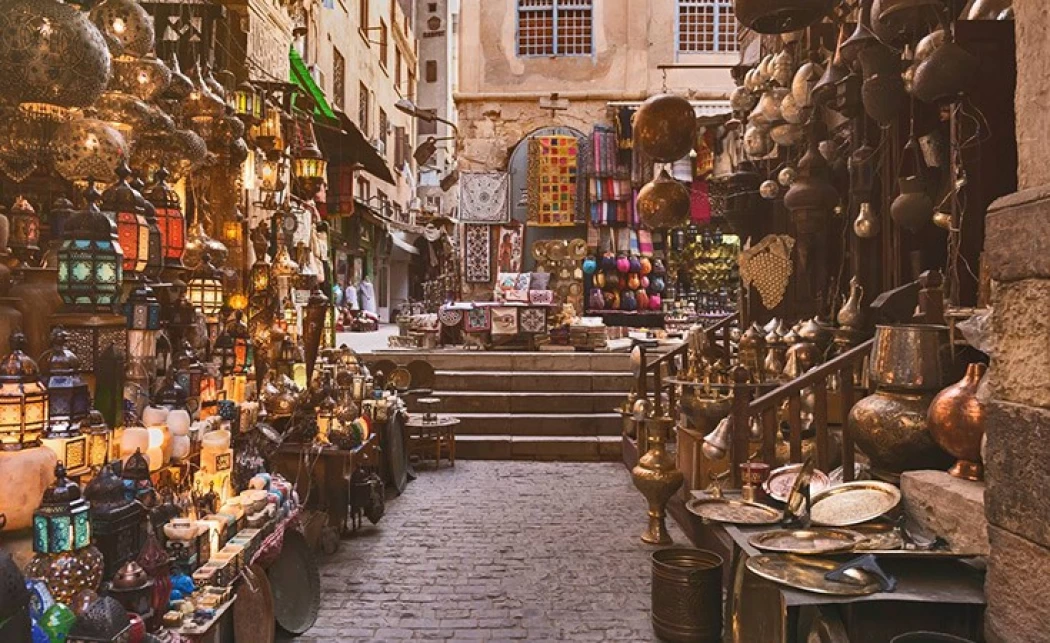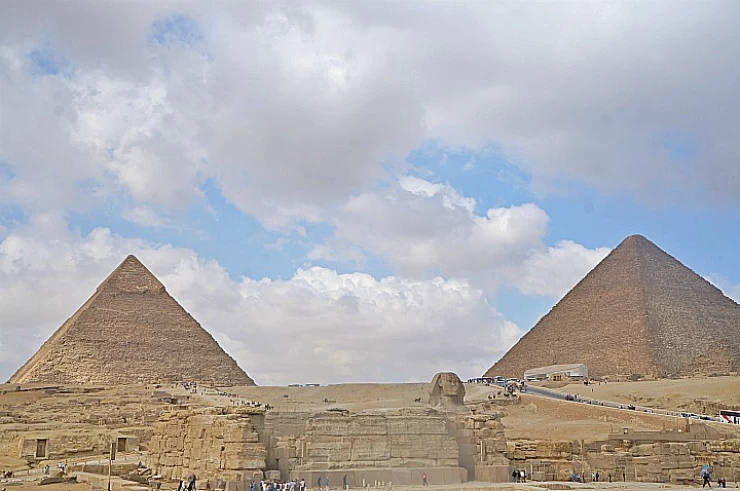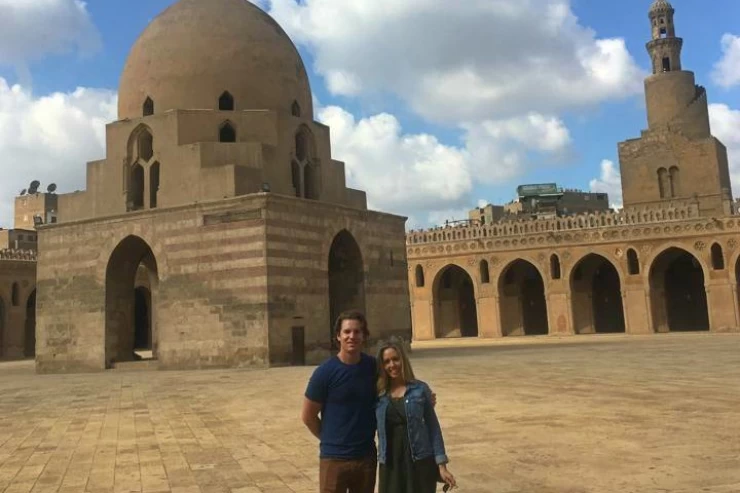
Khan El Khalili
Khan El Khalili
It is set within the framework of all tourism in Egypt today. In other words, the place appeals to various tourists, contributing to its viability as a trading point, from where tourists come and leave with elements fulfilling their needs and satisfying their whims: bazaars, restaurants, and shops retailing different products, so it is a vital tourist magnet. Khan al-Khalili has served as a refuge not only to foreigners but also to Egyptians, whose writers and authors have been inspired by the bazaar, one of them being Nobel Prize winner Naguib Mahfouz, who wrote about an entire novel in its name, "Khan al-Khalili."
More interesting, however, is that whereas time has had little impact on Khan al-Khalili, Khan al-Khalili has affected people from various nations. A section of the Khan al-Khalili was a marketplace where merchants came from different countries; it was a major trading place in the Middle Ages.
Merchants came to it from India, Persia, Turkey and many African countries, and Khan al-Khalili sold various things like spices, precious metals, textiles, and other valuable goods, making it an important destination for trade caravans coming from all countries of the world.
The khan is a building in the shape of a large square, surrounding a courtyard and covering the lower layer of shops, and is divided into two layers, including the middle layer, in which there are shops and merchants, while the other class is for the rich, in which homes and apartments abound.
The name Khan Al-Khalili came from the person who built it in the previous Mamluk era, Jaharkesh Al-Khalili, but after the death of this prince, Kansouh Al-Ghuli came and removed Khan Al-Khalili and placed shops, stores, and places to sell goods instead. On the other hand, all that happened, and it still keeps its heritage from the Mamluk era.
It has a unique architectural pattern that combines beauty with practicality because it was built in an alley system branching from the streets into narrow retail spaces, which promotes free movement inside the market. The unique feature of the shops there is that they are beautifully ornamented with some traditional Islamic writings and decorations expressing the marvelous oriental style within its various ages, like, for example, the Mamluk and Ottoman ages.
Khan al-Khalili Story
Jaharkes Al-Khalili wanted to build himself a Khanah to sell different types of goods, so he wanted the area to be special, and he did not find a better place than this place near the Sultan Barqouk Mosque and the Bin Al-Qasrin area, where Al-Moez Street is one of the oldest and most wonderful Egyptian streets since the Middle Islamic eras.
The area he chose included the graves of the Fatimid caliphs, which required him to build over their graves or remove them to start construction—a decision that was not easy to make without recourse to an important religious figure at the time, so he turned to the judiciary, which ordered him to build what he wanted because they considered the Fatimids to be out of religion.
After that, he removed the Fatimids' relics and threw them in another place, and this place is now Al-Azhar Park, where many people go to sit to spend an enjoyable time talking among themselves, and among those who moved their relics is Al-Moez Din Allah, the founder of the Cairo city.
Then Al-Khalili died in one of the battles a few years later. Sultan Al-Ghuri came and began to change everything inside Khan Al-Khalili, where he demolished everything built by Juharex and built it again, where he built agencies and shops to become the most important commercial center at this time and to enter the Khan through three gates.
A long time after Khan al-Khalili was built, it was moved to a very strange place, the slave market, which is not a great place to buy what you want and how to sell slaves with other purchases, but this is in the past, and we are now in a new and better era.
Things to do in Khan El Khalili
Before you start your tour inside Khan al-Khalili, you should go to Al-Fishawi Coffee, the most famous cafe in this place, which is more than a hundred years old, but it is special with its wonderful atmosphere that if you sit down, you will never get bored, and then you take a tour inside the old quarter to see the masterpiece from the Mamluk era and enjoy the dazzling old atmosphere.
There are places where you can drink different types of drinks, and there are shops selling gold, clothes, and all kinds of goods there are papyrus papers written in hieroglyphics, and some of them are written with stories about the pharaohs, including the story of Isis and Osiris.
The Egyptians are the most famous people in the Arab world who can make you laugh, and the merchant there tries to convince you to buy from him. This in commerce is an art called the art of selling, and this art began a long time ago, as Khan Al-Khalili used to put similar goods next to each other to allow the customer to choose the best thing he wants from among all these shops, and also this increases the rivalry between merchants, as it is characterized by the availability of the most wonderful handmade goods that are brilliantly made, and this art is one of the largest arts that Egypt is characterized by, so Khan El-Khalili is a wonderful place to attract many tourists annually.
There are some goods that people buy more often than others, like exquisite clothes and ancient art, especially women who used to buy a necklace for the Eye of Horus, the ancient Egyptian god, in addition to various types of jewelry that women from all over the world use.
There is also one of the most important streets in the area, which is Moski Street, which includes various types of jewelry and turquoise stones that always attract tourists. On Moski Street there are the most luxurious types of perfumes and drugs from many countries and distinctive Egyptian perfumes like amber and yasmin.
In Khan Al-Khalili, there is something called incense, and this is the most unique thing that is characterized by it, as it has many different types and different beautiful smells. There is a belief that the smoke called mastic prevents jealousy, so if you go to Khan Al-Khalili, there is no doubt that you will want to return.
Khan KEl Khalili Bazaar is omnipresent in Islamic Cairo as the oldest and most well-known market in the Middle East. Tracing its origins back to the 14th century, this colorful bazaar has been a center of trade, culture, and art for over 600 years. As a tourist or traveler who has come to Cairo more than once and knows the place inside and out, Khan El Khalili will always provide an experience that is packed with charm and historical significance, as well as that exotic, unforgettable touch.
A Walk Through History Emir Djaharks El Khalili formed Khan El Khalili in 1382, and he built it as a caravanserai where traders could rest and keep their goods. Over the years, it transformed into a huge bazaar where various regions’ traders gathered to sell spices, silks, and other precious metal products, among others. The bazaar continues to have narrow alleyways and cluttered stalls constructing similar old houses, which are such that the visitors feel as if they have traveled back in time.
Khan El Khalili is viewed as a priceless resource of ancient Coptic arts in modern Cairo, retaining its medieval elements. The market’s winding passages are filled with haggling customers and vendors, hungrily inhaling the scent of different spices, while artisans are busy producing everything from jewelry to leather.
Unveiling the Hidden Treasures of the MarketEvery nook and cranny in Khan El Khalili has something different to offer. This makes it a traveler’s and shopper’s utopia filled with endless options. These are some of the orders of interest:
Some of the founders: Find Khan El Khalili, and every Egyptian will get some handicrafts and souvenirs. In the bazaar, you’ll also find more than just delicately crafted gold and silver wear, including foreign hand-carved wooden boxes, and brass, and colored glazed mosaic lantern lamps. Hand-serrated: Several artists, such as glass blowers, carpet makers, and silver craftsmen, work in small studios within the market, allowing for their work to be seen in the process of creation. These are artists who have mastered their art over many years. Another interesting aspect of the very well-known marketplace is the perfume stores, which have Egyptian-made perfumes in small, fragrance-filled glass bottles easily arched for cheap prices. These perfumes are made from plants made in Egypt.
2. Medicinal plants and spice shops
Stirring Hints of Tantalizing Spices: The spice markets of Khan El Khalili are a sight to behold. You will find large piles of various spices, such as saffron, cumin, cardamom, cinnamon, and many more, filling the stalls and creating a rich aroma. Healthy Stuff: As well as that, you are likely to come across natural herbs and some other products, like tea made out of hibiscus flowers, black seed, and camphor. Some of them sell these herbs and answer questions regarding the side effects of these herbs.
3. Papyrus and Ancient ObjectsPapyrus Art of Ancient Egypt: As you stroll around the market, you will find many stores depicting Egyptian art on papyrus where talented artists reproduce scenes from ancient Egypt. Such unique paintings feature deities, the royal rulers, and even the ancient writing system, providing a glimpse of the history of Egypt.
Reproduction Artifacts: There are various statues of ancient Egyptian gods, such as the dog-headed god Anubis, goddess Bastet, and Horus, as well as other mock tomb-style jewellery sold at some of the stores in the area.
Textiles and Dressing Dresses and Garments: For those considering themselves fashionistas of some sort, the bazaar also offers not only definitely outdated but some stylish galabeya long robes and even kaftan dresses, along with some embroidered scarves and shawls.
Traditional Weaves: Other striking traditional handlooms, together with carpets like Egyptian cotton and kilim, tell much about the area’s interlacing art.
Khan El Khalili Hotels: Landmarks and GastronoIn addition to shopping, there is a possibility for tourists to enjoy the typical food of the country and get acquainted with the culture in som
1. El Fishawi’s Café:
the one owned for centuries (Café of Mirrors)Historical Context: El Fishawi’s Café is one of those old Cairo cafes that has withstood the test of time over 200 years. The place has been visited by most renowned Egyptian authors, painters, and intellectuals, and therefore, eternally seems frozen in time.
Atmosphere and Ambiance: Situated at the center of the bazaar, El Fishawi’s has an inviting warm atmosphere, owing to its adorned walls with mirrors, wooden tables, and busy patrons. It is an ideal place for taking a break while sipping either mint tea or Turkish coffee and simply enjoying the passing crowd.
Shisha Tradition: For those interested in trying shisha, El Fishawi’s is an excellent place to indulge in this traditional water pipe, available in a variety of flavors, from apple to grape.
2. Local street food
Delectable Snacks: As you wander through Khan El Khalili, you’ll find street vendors selling Egyptian snacks such as taameya (Egyptian falafel), samosas, and koshari. These treats offer a delicious and affordable way to experience the local cuisine.
Sweet Delights: Don’t miss out on basbousa (sweet semolina cake) and konafa (a dessert made from thin noodles soaked in syrup), which are popular Egyptian sweets.
Cultural Experiences: Art, Music, and Stories
Khan El Khalili is not just a marketplace; it’s a cultural hub where you can immerse yourself in Cairo’s vibrant arts scene.
1. Traditional Sufi Performances
Al-Tannoura Dance Troupe: At Wekalet El Ghouri, a nearby historic venue, you can witness the Al-Tannoura Dance Troupe, which performs a mesmerizing blend of Sufi music and dance. The whirling dervishes, dressed in colorful skirts, spin in time with the music, creating a hypnotic display of devotion and artistry.
2. Live music and street performersStreet Artists: Throughout the bazaar, you may encounter street performers, including musicians playing traditional instruments like the oud and qanun, adding to the lively atmosphere of the market.
Storytellers: Occasionally, you may find traditional storytellers, or hakawati, who share folk tales and legends of Cairo, providing a glimpse into Egypt’s rich oral history.
An early evening visit would be best since the bazaar starts lighting up, with the sound of music and performances turning Khan El Khalili into a stage for living culture.


















